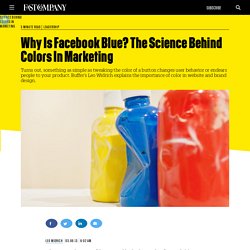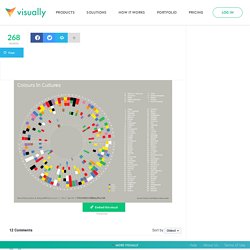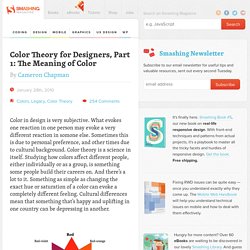

53d55603be17f6a517a768c033d44583.039997f500f6a05f05f8a82a49862a1f.png (PNG Image, 1500 × 1314 pixels) - Scaled (68%) What Your Logo's Color Says About Your Company (Infographic) When it comes to identifying your brand, your logo is probably the first thing your customers will think of.

While honing the narrative and message behind your logo should of course be your primary concern, research suggests that your logo’s design–and specifically its colors–have more bearing on your customers’ opinions than you might think. Neuroscientist Bevil Conway, who has focused his recent research almost entirely on the neural machinery behind color, believes the science behind color processing to be very powerful and completely underexploited. “Knowing that humans might … be hardwired for certain hues could be a gateway into understanding the neural properties of emotion,” he told Co.Design earlier this month.
Goethe on the Psychology of Color and Emotion. Color is an essential part of how we experience the world, both biologically and culturally.

One of the earliest formal explorations of color theory came from an unlikely source — the German poet, artist, and politician Johann Wolfgang von Goethe, who in 1810 published Theory of Colors (public library; public domain), his treatise on the nature, function, and psychology of colors. Though the work was dismissed by a large portion of the scientific community, it remained of intense interest to a cohort of prominent philosophers and physicists, including Arthur Schopenhauer, Kurt Gödel, and Ludwig Wittgenstein. One of Goethe’s most radical points was a refutation of Newton’s ideas about the color spectrum, suggesting instead that darkness is an active ingredient rather than the mere passive absence of light. YELLOWThis is the color nearest the light. It appears on the slightest mitigation of light, whether by semi-transparent mediums or faint reflection from white surfaces. Education Facility Guide. Why Is Facebook Blue? The Science Behind Colors In Marketing. Editor's Note: This is one of the most-read leadership articles of 2013.

Click here to see the full list. Why is Facebook blue? According to The New Yorker, the reason is simple. It’s because Mark Zuckerberg is red-green color blind; blue is the color Mark can see the best. Not highly scientific, right? So how do colors really affect us, and what is the science of colors in marketing, really? Colour-language.jpg 550×584 pixels. Originally published in the June 2013 issue of Architectural Record.
Smart choices in color and design facilitate the learning process June 2013 Continuing Education Use the following learning objectives to focus your study while reading this month’s Continuing Education article.

Learning Objectives - After reading this article, you will be able to: Explain the color and design choices that benefit the developmental stages of children in the school environment from grades K through 12.Describe the philosophy of educational professionals, design authorities, and education researchers on the basic principles of school design and structure that promotes the health, safety, and well being of students.Discuss each color palette combined with an understanding of light reflectance values in the design process to create effective school environments.Identify appropriate color and design choices for major areas and rooms within the education environment.
Credits: 1.00 HSW. Color Scheme Designer 3. The Evolution of Typography. What Colors Mean in Different Cultures. Colours in Cultures A Western / American B Japanese C Hindu D Native American E Chinese F Asian G Eastern European H Muslim I African J South American 1 Anger 2 Art / Creativity 3 Authority 4 Bad Luck 5 Balance 6 Beauty 7 Calm 8 Celebration 9 Children 10 Cold 11 Compassion 12 Courage 13 Cowardice 14 Cruelty 15 Danger 16 Death 17 Decadence 18 Deceit 19 Desire 20 Earthy 21 Energy 22 Erotic 23 Eternity 24 Evil 25 Excitement 26 Family 27 Femininity 28 Fertility 29 Flamboyance 30 Freedom 31 Friendly 32 Fun 33 God 34 Gods 35 Good Luck 36 Gratitude 37 Growth 38 Happiness 39 Healing 40 Healthy 41 Heat 42 Heaven Gray Yellow Silver Gold David McCandless & AlwaysWithHonor.com//v1.0//Apr 09 // InformationIsBeautiful.net.

Color.hailpixel.com · Swatch you doing? Color Theory for Designers, Part 1: The Meaning of Color. Color in design is very subjective.

What evokes one reaction in one person may evoke a very different reaction in somone else. Sometimes this is due to personal preference, and other times due to cultural background. Color theory is a science in itself. Studying how colors affect different people, either individually or as a group, is something some people build their careers on. And there’s a lot to it. This is the first in a three-part series on color theory. Warm Colors Link Warm colors include red, orange, and yellow, and variations of those three colors. Red and yellow are both primary colors, with orange falling in the middle, which means warm colors are all truly warm and aren’t created by combining a warm color with a cool color.
Red (Primary Color) Link Red is a very hot color. Red can be associated with anger, but is also associated with importance (think of the red carpet at awards shows and celebrity events). Outside the western world, red has different associations. Sphere: Color Theory Visualizer.